I’m excited to explore the world of Amazon Frogbit with you! This floating plant is super popular in the aquarium community — over 22,000 people have checked out care guides and setup tips. Those charming heart-shaped leaves aren’t just pretty; they’re great for your tank’s overall health too.
After chatting with 13 experts, we’ve learned some key tips for keeping Amazon Frogbit happy. The right water movement, lighting, and using fertilizers like Excel and Flourish are crucial for its growth. It’s a bit particular about temperature, loving the range of 65-84°F, and even though it’s a hardy plant, it does need some time to settle into a new tank.
Let’s dig into how to keep Amazon Frogbit thriving. We’ll cover the best pH levels (between 6.5 and 7.5) and how quickly this plant can spread. With the right care, you’ll create the perfect environment for your Frogbit to flourish.
So, let’s dive into aquascaping with Amazon Frogbit, a plant that does more than just look good—it plays a big role in keeping your aquarium healthy. Whether you’re crafting a stunning aquascape or just want a vibrant, balanced tank, I’m here to help you make your Frogbit thrive.
Understanding the Basics of Amazon Frogbit
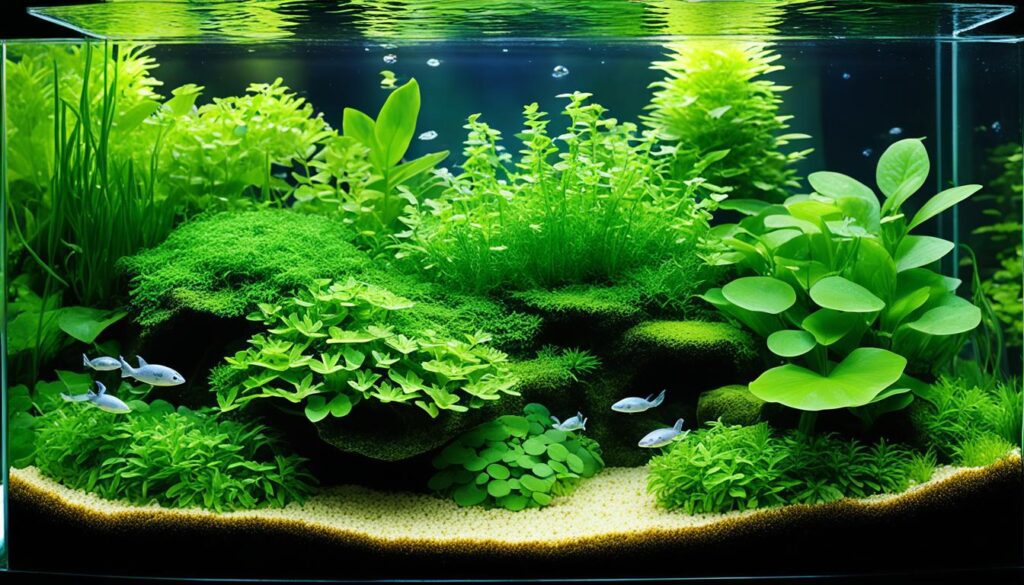
Welcome to the amazing world of Amazon Frogbit (Limnobium laevigatum). It’s a top pick for freshwater aquarium lovers. We’ll cover the key points of Amazon Frogbit, showing how it makes your aquarium feel more natural.
What is Amazon Frogbit?
Amazon Frogbit is a floating plant that grows fast and is easy to care for. It has heart-shaped leaves and thin roots. It lives in the slow waters of the Amazon Rainforest. Its adaptability makes it perfect for freshwater aquariums, mimicking real aquatic habitats.
The Natural Habitat of Frogbit
Amazon Frogbit loves warm, nutrient-rich water. It forms thick mats on the water surface. This helps control light and oxygen levels and gives a home to many water animals. Frogbit is found in Central and South America, in warm climates.
Why Aquarists Love Amazon Frogbit
People who keep fish like Amazon Frogbit for many reasons. It makes tanks look nice and helps clean the water. It also gives fish and small water animals a place to hide. Frogbit grows quickly, providing cover for young fish. It helps create a balanced, natural fish tank environment.
Creating the Perfect Tank Environment for Frogbit
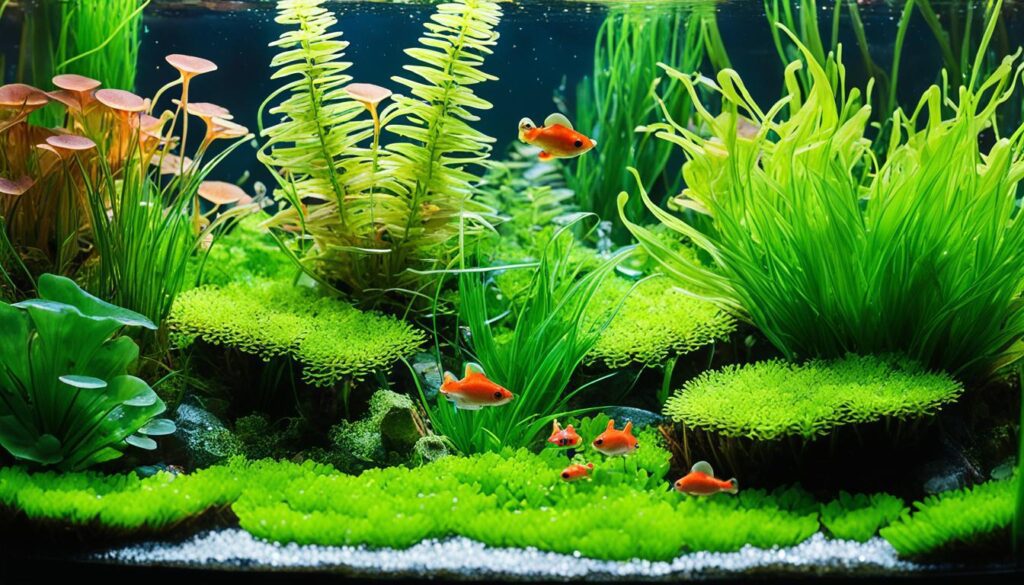
To make a great aquarium environment for Amazon Frogbit, we need to copy its own tropical fish habitat. It comes from the quiet, freshwater areas of Central and South America. Amazon Frogbit does best in warm settings just like home. I’ll share how to get your aquarium just right for Frogbit’s growth.
- Water Temperature: Keeping the water at 65-84°F is key for mimicking the warm waters where it naturally lives.
- pH Levels: It’s best to keep pH levels between 6.5 and 7.5. This makes sure the water isn’t too acidic or basic.
- Substrate Choices: I like mixing clay, silt, or sand with rocks and wood. This mix provides nutrients and helps plants stay put.
- Water Cleanliness: It’s important to change the water often and not overfeed. This keeps nitrates low and stops algae from blocking light.
Getting these basics right helps make a good home not just for Amazon Frogbit, but other aquarium life too. A little water movement is good, like the slow rivers it comes from. But too much filter action can upset the plant’s top.
Wrapping up, if you copy the right freshwater ecosystems in your tank, your Amazon Frogbit will do more than just live. It will flourish, making your aquarium look and feel alive.
Navigating the Acclimation and Planting Process
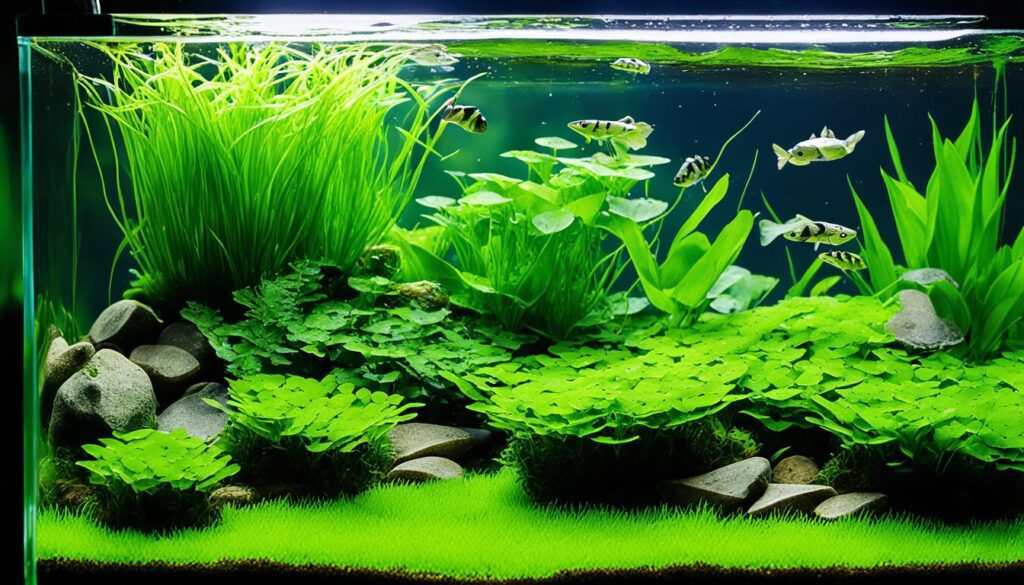
To start a great aquatic setup with Amazon Frogbit, learn about the acclimation process first. This step is key for the plant to get over the stress of moving and get used to the new water conditions. You might see some leaves fall off or melt in the first few weeks. This is normal as the plant adjusts.
For floating plants like Amazon Frogbit, how you plant them affects their health and growth. It’s crucial to space them out to prevent crowding. This keeps your water garden looking good. Make sure water flows softly to keep the plants steady. They shouldn’t get pushed under water. Trimming off bad leaves will spark better growth. It also keeps your water garden beautiful.
Acclimating Amazon Frogbit to Your Tank
Begin the acclimation process by putting the Frogbit in a separate tank first. This protects your main tank from pests or diseases. It also lets the plant get used to your tank’s conditions like temperature, light, and pH levels. This makes moving it to the main tank easier later.
Planting Techniques for Floating Plants
With aquarium planting, keeping things simple and well-planned is vital. Ensure each Amazon Frogbit has enough space to grow without fighting for light. Don’t let them crowd together. This blocks the light and limits their growth. Keeping the Frogbit in certain areas makes your tank look good. It also makes feeding and care easier.
Using these tips for Amazon Frogbit will improve your aquatic setup. With time and care, your aquarium will bloom with beautiful, floating green plants. They bring a calm and lush look to your water world.
Essential Care Tips for a Thriving Amazon Frogbit

Taking care of your healthy aquascape means paying attention to the needs of plants like Amazon Frogbit. This plant is easy to take care of and looks great. It makes the water better and gives fish a place to hide. I will show you important steps to keep your Amazon Frogbit looking good. This helps your whole aquarium.
- Light Requirements: Amazon Frogbit needs medium to high light. This light helps the plant make food from sunlight. It stays healthy and can beat algae for nutrients.
- Water Quality: This plant does well in water with a pH of 6.0 to 7.5 and 0-12°GH hardness. Check the water often to keep it right, so your plants stay healthy.
- Temperature: Keep the water between 64 – 80°F (18 – 26°C) for Amazon Frogbit. Avoid big changes in temperature to prevent stress on the plant.
- Pruning: Trim the plant to control its size and stop it from covering too much. Remove bad leaves to keep it looking nice and healthy.
Knowing Amazon Frogbit’s role in the ecosystem helps manage it better. It uses nutrients from the water, which keeps the water clear and balanced. This helps to stop too much algae, which can mess up your tank.
In the end, good Amazon Frogbit maintenance makes your healthy aquascape even better. It helps your plants do their best. If you keep up with these tips, your aquarium will be a lively, beautiful place.
Optimizing Water Quality for Amazon Frogbit
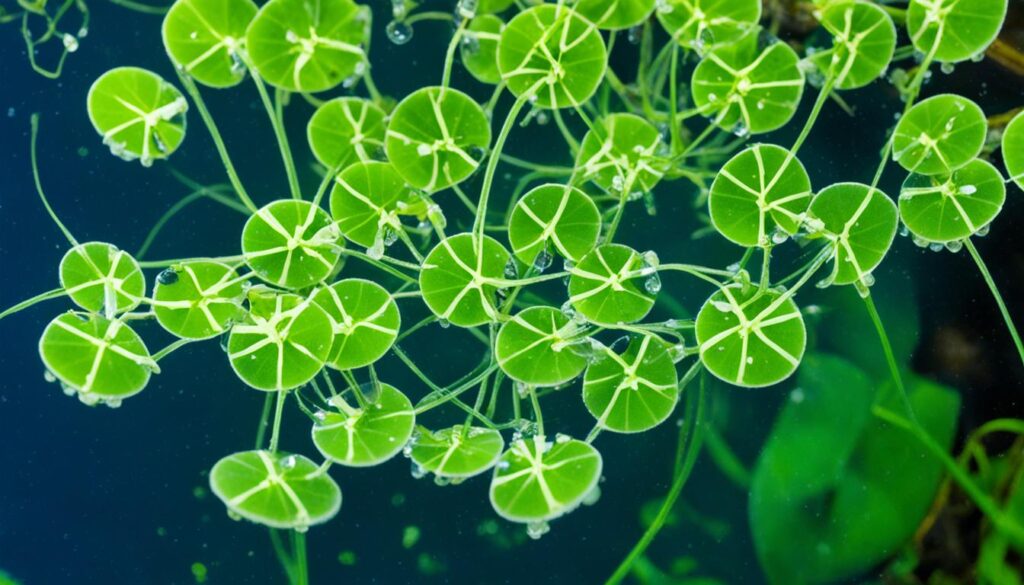
To keep Amazon Frogbit healthy, it’s key to know about the water it needs. Keeping the aquarium pH, hardness, and temperature right helps the plant. It also makes the whole aquarium better.
The right water temperature is between 68°F and 82°F. This mirrors the warm conditions where Amazon Frogbit comes from. Staying in this range helps the plant grow strong and healthy.
Preferred pH Levels and Hardness
Amazon Frogbit does best with certain pH levels. A pH from 6.0 to 7.5 is ideal. This range keeps the plant growing well and avoids stress. Keeping the water hardness at 2-15 dKH is also crucial. It stabilizes the water, helping the plant get nutrients and stay healthy.
Water Temperature and Purity
Clean water is very important because Amazon Frogbit has delicate roots. Clean, filtered water keeps the plant healthy. It also stops algae from growing, which can hurt the plant’s ability to make food from light.
Parameter |
Optimal Range |
Benefits |
|---|---|---|
Temperature |
68-82°F |
Mimics the natural tropical environments, enhances metabolic processes. |
pH Level |
6.0-7.5 |
Supports efficient nutrient uptake and stress reduction. |
Hardness (dKH) |
2-15 |
Assists in maintaining stable aqueous conditions. |
Check and adjust these water conditions regularly. This keeps the water quality just right for Amazon Frogbit and other life in the tank.
Shedding Light on Amazon Frogbit’s Requirements
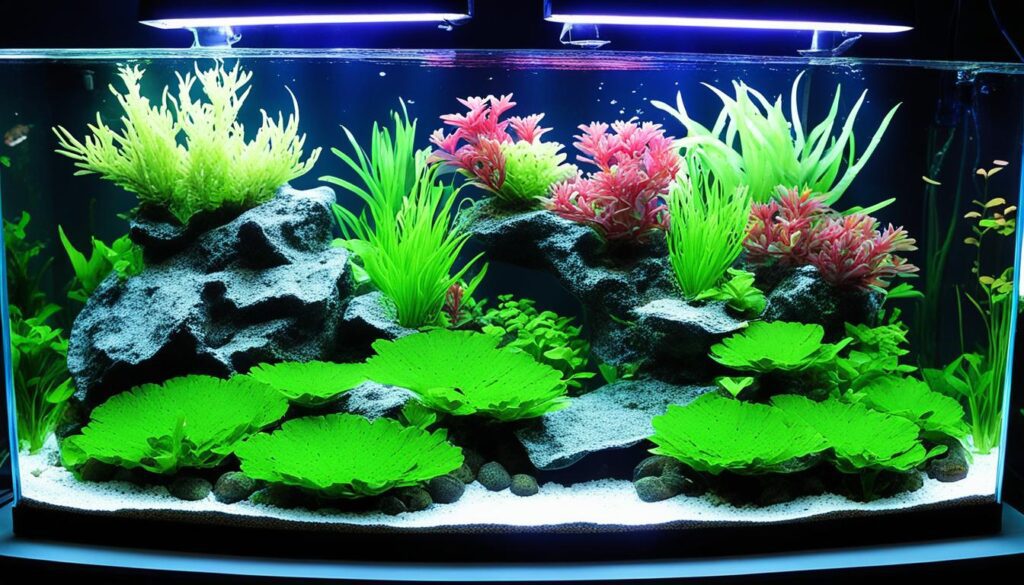
To care for Amazon Frogbit well, it’s key to understand aquarium lighting. This impacts plant growth and aquatic plant care a lot. As a floater, its light needs must be met. This makes your tank a perfect place for it.
Intensity and Duration of Light
Amazon Frogbit does best with the right light balance. It needs light like it would get in the wild. This prevents algae from growing too. Algae fight the plants for light and food.
They need indirect aquarium lighting to avoid damage. Direct light is too harsh for them.
Best Lighting Setups for Floating Plants
To help Amazon Frogbit grow well, mix incandescent and T-5 fluorescent lights. This setup spreads light evenly. Every plant gets the light it needs.
- Incandescent bulbs give off a warm light. This is good for cooler times.
- T-5 fluorescents are better for simulating midday sunlight.
Keep lights on for 10-12 hours a day. This is right for plant and tank health. You might need to change this based on your tank’s needs and algae.
Good lighting is key for Amazon Frogbit’s success. It makes your tank look better and keeps its balance. You’ll take care of your plants and your tank as a whole.
Fertilization: Feeding Your Amazon Frogbit Right
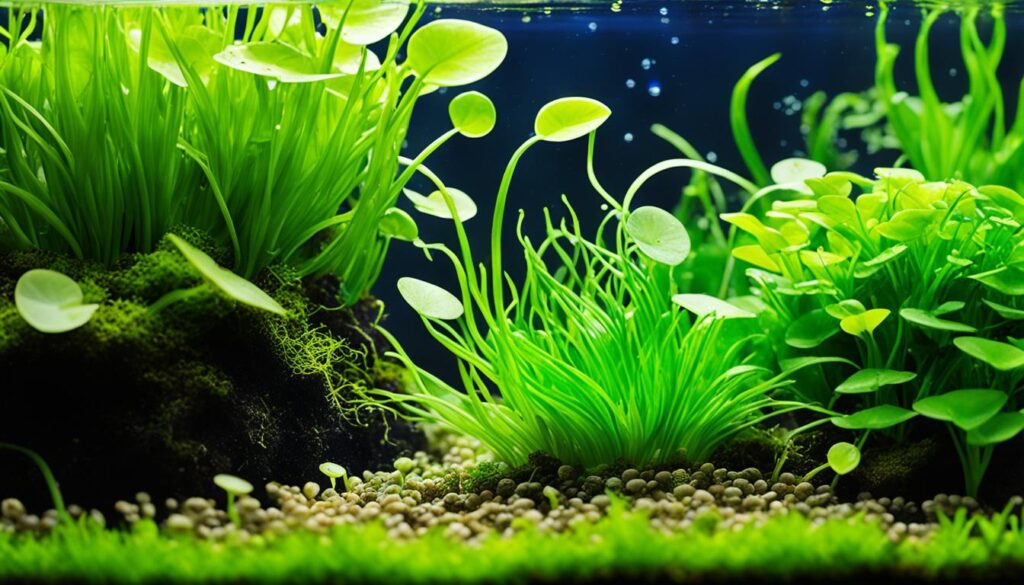
To grow Amazon frogbit well, it’s important to know how to fertilize correctly. This keeps your floating plant healthy. Amazon Frogbit gets its nutrients from water, through its leaves. But it takes more than basic care for it to flourish.
Water column fertilizers are key for aquatic plant nutrition. They help Amazon Frogbit grow strong. These fertilizers dissolve in water, making nutrients easy for the leaves to absorb. Using a mix like Osmocote+ capsules gives plants what they need safely.
- Enhance the amount of nitrogen for robust leaf production.
- Include potassium to aid in the overall physiological strength of the plant.
- Apply iron supplements to prevent chlorosis, keeping leaves vibrant and green.
Adding the right nutrients can make your tank look lush. I’ve talked with others on online forums. We shared advice on getting the nutrients right. This prevents problems like yellowing leaves and decay.
Here’s a tip: Amazon Frogbit likes calm water. A gentle filter flow works best. It spreads nutrients without harming the roots. Many people who grow aquatic plants agree with this.
Finally, the placement of other plants affects your Frogbit’s growth. The right balance ensures all plants get enough light and nutrients. Adjusting your fertilization method as plants grow and seasons change helps keep Frogbit healthy. Good plant supplements improve your aquarium’s entire ecosystem.
Mastering Growth Control of Amazon Frogbit in Your Tank
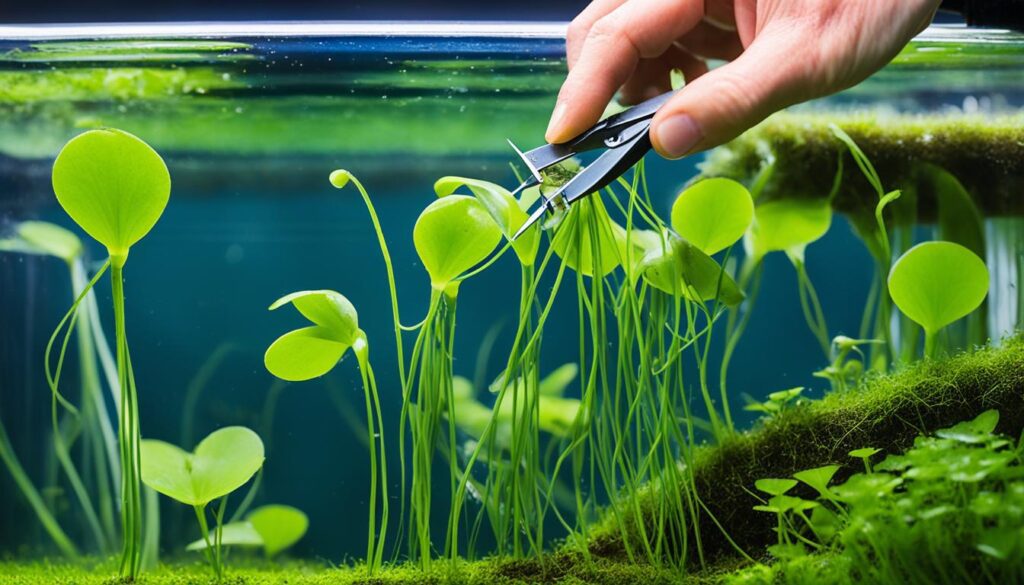
Keeping Amazon Frogbit under control is key for any fish tank lover. It’s important for your tank’s health and look. You need to prune, propagate, and keep your tank clean regularly. This helps your plants help your tank’s ecosystem without taking over.
Tackling Overgrowth and Maintaining Aesthetics
Amazon frogbit can grow too much. It can block light and use up oxygen, hurting other water life. It’s important to prune your plants often to keep your tank looking good and healthy for your fish and plants. Use a sharp knife to cut back the frogbit every week. Make sure it doesn’t cover more than one-third of your tank’s surface. This helps keep the light and oxygen at good levels for a healthy tank.
Pruning and Propagation Techniques
Propagating Amazon Frogbit not only increases your plant collection but also helps in managing your tank well. When you prune, pick good pieces of frogbit to replant. This encourages new, manageable growth. It’s a great way to use extra growth, maybe even to set up another tank or share with friends.
Floating Plant |
Light Requirement |
Weekly Maintenance |
Propagated from Pruning? |
|---|---|---|---|
Amazon Frogbit |
Medium |
Trim to avoid tank coverage beyond 1/3rd |
Yes |
Duckweed |
Low |
Regular thinning |
Yes |
Water Lettuce |
High |
Prune to prevent overcrowding |
Yes |
Salvinia |
Low to Moderate |
Control to manage light penetration |
Yes |
By doing these things often, you can make sure your Amazon frogbit and other plants do well. This makes your aquarium healthy, good-looking, and fun to take care of. Always being consistent is the best way to keep your tank’s balance in check.
Aquascaping: Designing with Amazon Frogbit
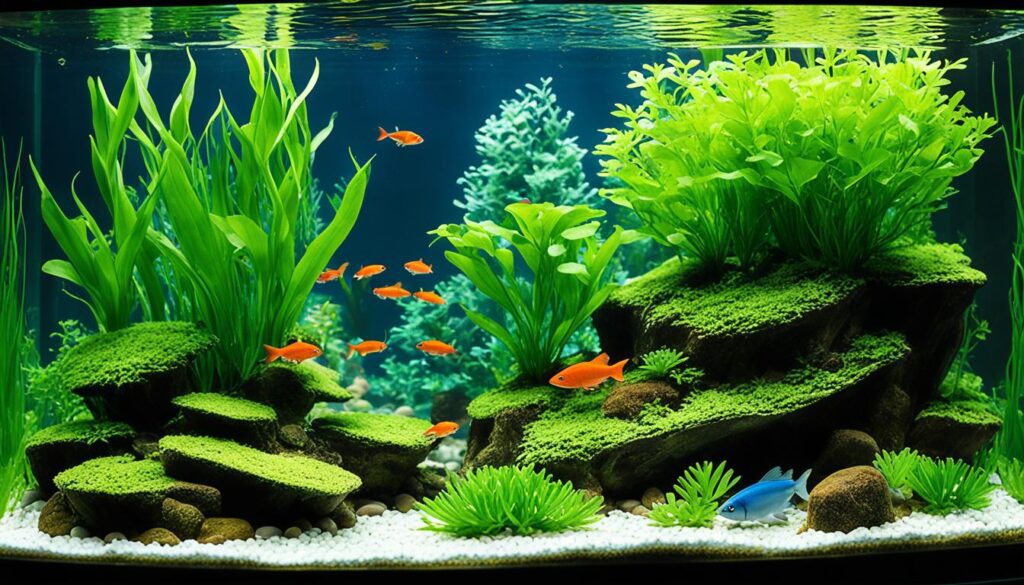
I love the look of Amazon Frogbit in aquariums. It makes the water space serene and beautiful. Its unique look is ideal for those wanting aquatic design with balanced aquariums and plant diversity.
Using Frogbit involves creativity and knowing about its needs. It can change an aquarium’s look but must work well with other plants. This keeps the aquarium’s environment in balance.
Incorporating Frogbit into Aquascaping Themes
Frogbit fits well in many aquascaping styles, like the lush Dutch or simple Japanese. In Dutch designs, it creates a green top layer. This looks great with the structured plants below.
Creating Balance with Other Aquatic Plants
To keep your aquarium balanced, mix Frogbit with other aquatic plants. Plants like Vallisneria or Cryptocoryne work well under Frogbit’s shade. This creates a beautiful, multi-level effect.
Adding Frogbit to aquariums is popular and beneficial. It helps in creating healthy and pretty underwater spaces. By choosing plants carefully, aquascapers can make a beautiful and natural-looking water environment.
Troubleshooting Your Amazon Frogbit
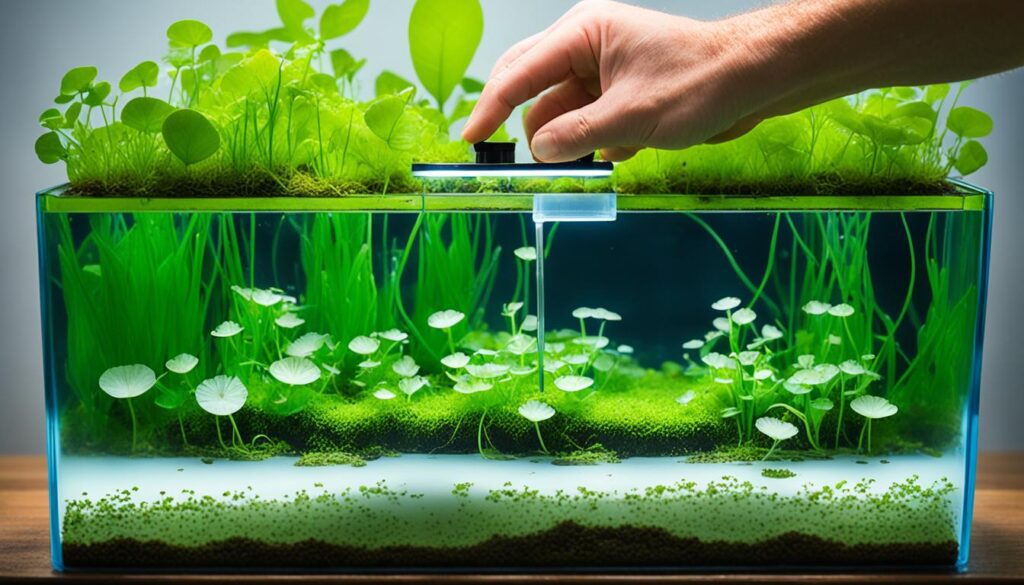
If you’re facing common issues with frogbit like yellow leaves or slow growth, you’re not alone. Identifying these aquarium problems can make your tank healthier. Let’s look into solving these troubles for a better floating plant ecosystem.
First, it’s crucial to check certain environmental factors that affect frogbit. Make sure your tank aligns with the plant’s needs. Check the following:
- pH levels and water temperature consistency
- Nutrient availability in the water
- Appropriately calibrated lighting conditions
Yellow leaves usually mean the plant needs more nutrients. Amazon Frogbit thrives on a diet full of minerals. If leaves melt, it could be too much light or not enough nutrients like nitrogen or iron.
Fast growth can cause problems, like too much plant cover. It can make your tank look messy and reduce oxygen for fish. Keeping your frogbit trimmed and spaced out will help keep your tank looking good and healthy.
To avoid problems, check the official guidance on Amazon Frogbit. It’s full of helpful info.
Also, joining online communities or forums can be very helpful. People share troubleshooting floating plants advice there. You can learn a lot from others’ experiences with healthy frogbit tips.
By watching, tweaking, and talking with others, you can get good at keeping your Amazon Frogbit looking great. It turns troubleshooting into mastering your aquarium’s floating plant display.
Ensuring Compatibility of Amazon Frogbit with Tank Inhabitants
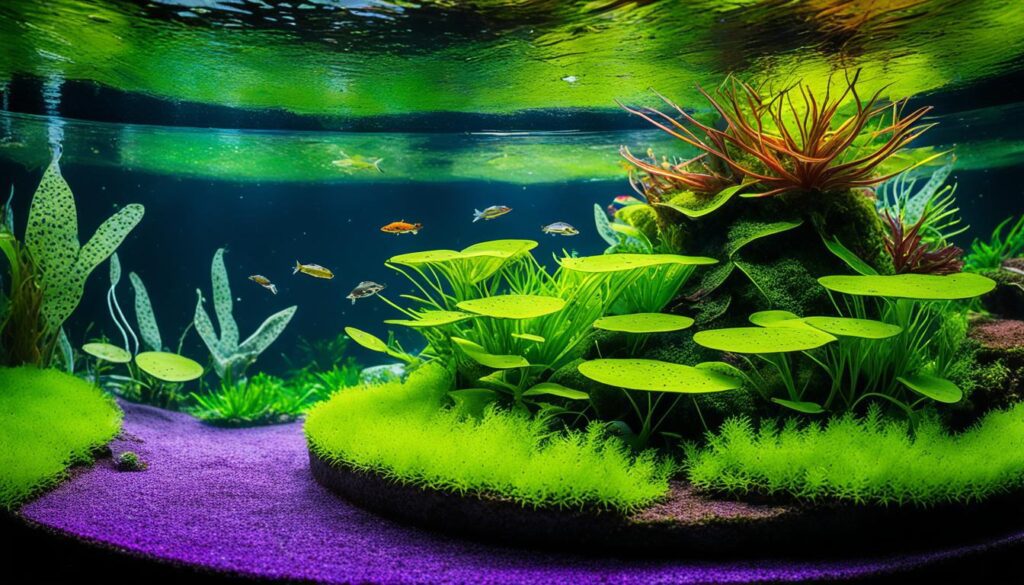
Keeping your aquarium in balance is key for supporting aquatic biodiversity. It also helps in making sure plants and fish grow healthily. Amazon Frogbit, known for its large floating leaves, can be a great choice for many aquariums. Yet, it’s important to make sure it fits well with frogbit tank mates to boost aquatic biodiversity.
Frogbit does best in calm waters. This means it’s perfect for tanks that don’t have strong water flow. Making sure the water isn’t too powerful is crucial. Too much flow could force the plants underwater, harming their fragile leaves.
Ideal Tank Mates for Frogbit
Choosing the right frogbit tank mates is crucial. Look for fish and creatures that won’t eat the plants. Peaceful fish and shrimp are great friends for frogbit. They live together without seeing the frogbit as food. Livebearers, like guppies and mollies, hide among frogbit’s roots. They help keep the tank clean, adding to aquatic biodiversity.
Species to Avoid with Floating Plants
Big fish or those that chew on plants can ruin the floating plant harmony. Stay away from big cichlids or goldfish as they can destroy frogbit. Snails are also a problem because they eat the soft leaves. This can hurt the look and health of your floating plants.
To get floating plant harmony, pick the right animals. But also look after the plants well. This includes spacing them out, making sure they have enough light, and not overfeeding. These steps help frogbit and its friends thrive in your tank. This creates a beautiful, balanced aquatic world.
Understanding the Ecosystem Benefits of Amazon Frogbit
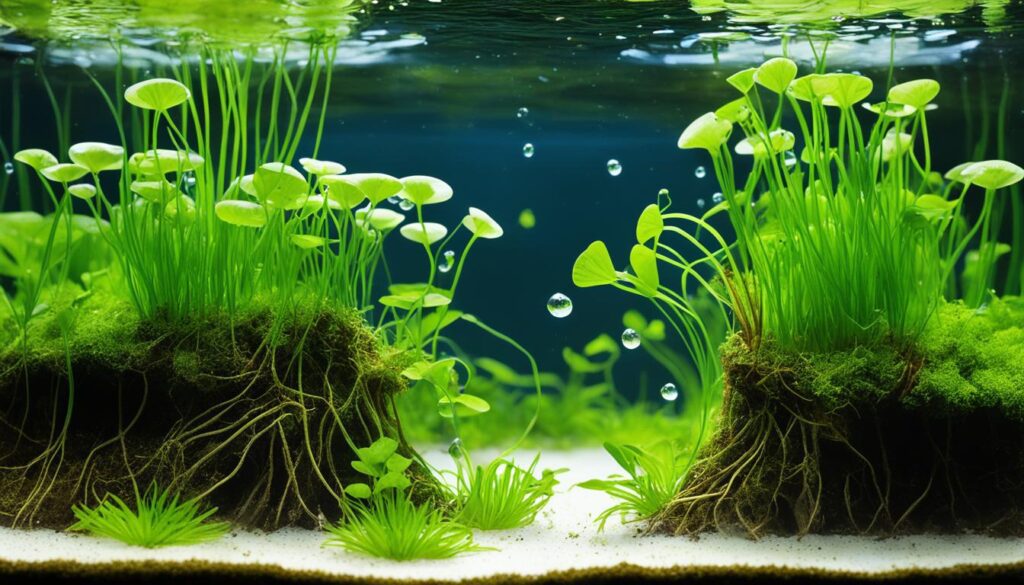
Amazon Frogbit floating on water is more than just pretty. This plant boosts the health of freshwater habitats. It enhances oxygen, filters the water, and gives aquatic creatures a home. Amazon Frogbit is key to keeping water environments balanced.
Amazon Frogbit is known for aquatic oxygenation. This keeps fish and other water life alive. Its leaves take in carbon dioxide and let out oxygen. This makes oxygen levels in the water better, helping all living things in the tank.
Oxygenation and Filtration through Amazon Frogbit
The plant’s roots are part of the natural filtration process. They catch debris in the water. This keeps the water clean and aids bacteria that help with the nitrogen cycle. This benefits the whole water ecosystem.
Frogbit as Shelter and Food Source
Amazon Frogbit also provides a safe place habitat for aquatic life. Its thick leaves make a perfect hiding spot. Smaller fish, babies, and shrimps hide among its roots. They find protection from dangers and strong currents here. The plant also feeds many water creatures, supporting a balanced ecosystem.
Feature |
Benefit |
|---|---|
Oxygen Production |
Improves aquatic oxygenation essential for aquatic life respiration |
Natural Filtration |
Cleans water by trapping particulates, supports beneficial bacteria |
Habitat and Food Source |
Provides shelter and breeding ground, natural food source for smaller aquatic animals |
Digging into Amazon Frogbit’s benefits, we see it’s not just for decoration. It is crucial for healthy water life. This plant improves water through filtration and oxygenation. It also offers shelter and food for many creatures. Amazon Frogbit is indeed an ecological hero.
Selecting and Purchasing Healthy Amazon Frogbit Specimens
Getting healthy Amazon Frogbit is crucial for keeping your aquarium balanced and thriving. Not only do these plants make your tank look amazing, but they also support the entire ecosystem inside. To pick the best Frogbit, look for bright green leaves, no signs of pests or decay, and strong, healthy roots — it’s a sign they’ve been well taken care of.
Choosing reliable suppliers isn’t just good for your tank; it’s also about being kind to the environment. Amazon Frogbit can become a real problem if not handled properly — it’s already invasive in places like Forster, NSW, and the Great Lakes.
Stick to shops that use sustainable, eco-friendly practices, and don’t hesitate to ask about their plant care and shipping methods. It’s a great way to gauge if they really care about the plants and the ecosystems they’re selling into.
Make sure your Frogbit arrives in good condition. Steer clear of plants that look dry or lifeless since they might not bounce back in your aquarium. Being mindful of your plant purchases helps keep your tank thriving while protecting local waterways from invasive species. Buying Amazon Frogbit the right way means you’re not just creating a healthy aquarium—you’re also doing your part to keep our ecosystems safe.








